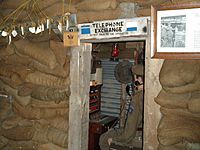Military Communications and Electronics Museum facts for kids
 |
|
| Established | 1961 |
|---|---|
| Location | Hwy 2 at Craftsman Blvd, Kingston, Ontario |
| Type | military museum |
| Collection size | 5000 items, 10000 square feet |
| Owner | CFB Kingston |
| Public transit access | 12A, E12 |
| Nearest car park | on-site |
The Military Communications and Electronics Museum is a special place in Kingston, Ontario, Canada. It's a museum all about how the military uses communications and electronics. Located at CFB Kingston, this museum shows how soldiers have talked to each other over the years.
The museum first opened in 1961. Later, in 1996, it moved into a new building made just for it. Inside, you can see how military communication has changed. It covers everything from the early 1900s, through big wars like World War I and World War II, and even up to today's communications satellites. It's a great way to learn about the history of military technology.
Contents
Exploring the Museum's Exhibits
The museum has many interesting displays that show how Canadian soldiers used communication tools. You can see mannequins dressed in military uniforms from different time periods. They are shown using old communication equipment in places like underground dugouts or military vehicles.
The history of Canadian military signals began in 1903. That's when the Canadian Signal Corps was formed. This group was the first of its kind in the Commonwealth. The exhibits are set up in order, starting from the time of World War I and going all the way to more recent missions, like the one in Afghanistan.
Tools from World War I
In the museum, you can see items from the Great War (World War I). These include a special wagon used for carrying cables. There's also a telephone switchboard like those used to direct artillery fire. You can also find Morse code equipment and gas masks. Soldiers had to keep gas masks ready in case of a chemical attack.
Secret Codes and Spying
The museum also teaches about secret messages and spying. This includes how armies used encryption (making codes) and signals intelligence (listening to enemy messages). During World War II, breaking the Enigma machine code was very important. It helped the Allied forces win key battles.
Radio Station for Soldiers
The museum has a working amateur radio station. This station is part of the Canadian Forces Affiliate Radio System (CFARS). It helps connect military families and personnel. The station uses special callsigns like CIW64 and VE3RCS. This system started in 1978. It uses volunteer radio operators and their equipment.
A Memorial to Heroes
There is a special war memorial at the museum called "Canada mourning her fallen sons." This memorial includes three plaster models. These models were created by the sculptor Walter Allward. He designed them when he was working on the famous Vimy Memorial in France.
Images for kids
See also
- CFB Kingston
- Fort Henry
- List of museums in Ontario


